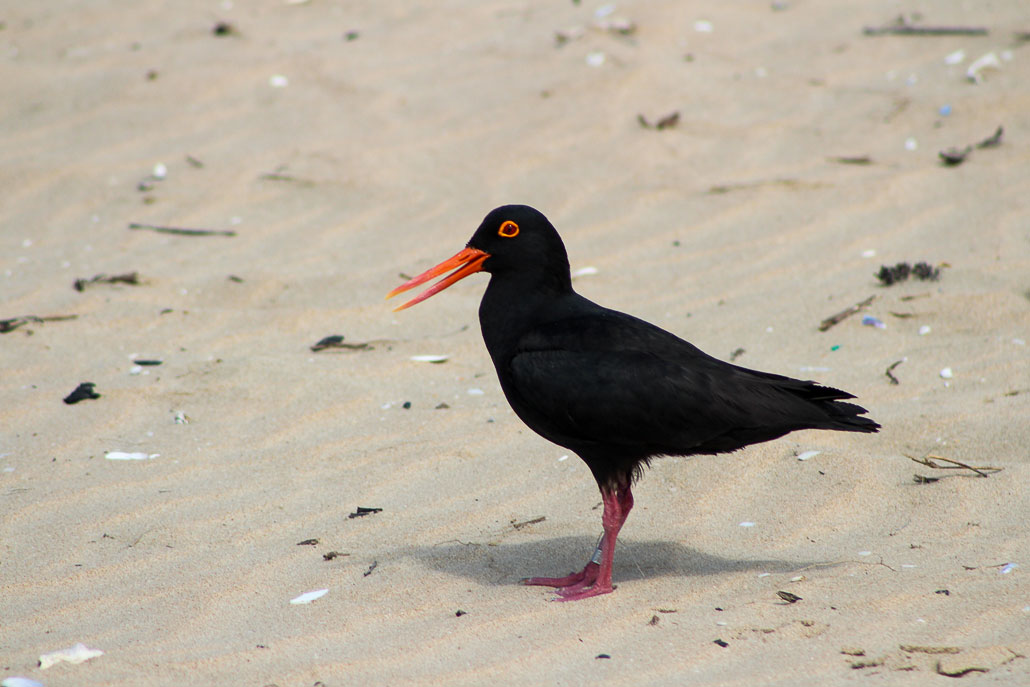
The Oystercatcher Trail
Share
The Oystercatcher Trail, named after the vulnerable African Black Oystercatcher that frequents the southern coastline, is a five-day guided hike along South Africa’s southern east coast. The trail starts in Mossel Bay and ends at Gouritsmond, though tide conditions sometimes require a reversal of direction. Of the five days, three are spent hiking, with the first as an orientation day and the last dedicated to breakfast and transfers.
- Beauty: 3.5/5 – Shoreline hiking at its best. The peri-urban sections slightly detract from the coastal splendour.
- Difficulty: 5/10 – Mostly flat and manageable, especially with slack-packing. Long distances may leave less-fit hikers with tired legs.
- Technical rating: Easy to moderate – mostly guided, on-trail walking. Expect long beach stretches on soft sand and light boulder hopping on Day 3.
Orientation Day (non-walking day)
Upon arrival in Mossel Bay, hikers spend the first evening at Ana’s Place apartments — elegant, four-star accommodation perched high on the hill with sweeping views of the harbour and beach pavilion. The group meets their guide, Chris, an experienced and softly spoken ex-Zimbabwean, along with the Oystercatcher team and conservation intern Katherine. Maps, brochures, and welcome drinks are shared, and camaraderie begins to bloom. Dinner follows at Louis Oosthuizen’s local restaurant, where laughter and shared hiking stories set the tone for the days ahead.
 The hiking group at Ana’s apartments in Mossel Bay (Image: Dania Petrik)
The hiking group at Ana’s apartments in Mossel Bay (Image: Dania Petrik)
Day 1 – Mossel Bay to Boggomsbaai (±14km, easy)
The day starts with a continental breakfast and an optional cultural tour to the Point of Human Origins (POHO) at Pinnacle Point — one of the world’s most significant archaeological sites. The hike begins from Ana’s Place through Mossel Bay’s residential area and onto the St. Blaize Trail, where ancient artefacts lie underfoot.
 Chris showing early human blades found in the Mossel Bay area (Image: Dania Petrik)
Chris showing early human blades found in the Mossel Bay area (Image: Dania Petrik)
The trail follows orange lichen-covered cliffs overlooking the sea. While the ocean vistas are magnificent, alien rooikrans trees dominate the path, providing an opportunity for ecological discussion. After reaching Pinnacle Point Golf Estate, the group tours the ancient caves with cultural guide Christopher, exploring 164 000-year-old sites that reveal early human innovation and the origins of symbolic art.
 Silhouetted against the entrance of cave 13b at Pinnacle Point (Image: Dania Petrik)
Silhouetted against the entrance of cave 13b at Pinnacle Point (Image: Dania Petrik)
After the tour, a transfer takes the group to Sandpiper Cottages in Boggomsbaai — spacious, comfortable, and private seaside cottages where hikers spend the next three nights.
Day 2 – Boggomsbaai to Dana Bay (±16km, easy to moderate)
With high tide expected in the early afternoon, the group reverses the usual direction, hiking from Boggomsbaai northwards toward Dana Bay. The long, pristine beach is home to nesting African Black Oystercatchers, their calls echoing across the dunes. Despite the natural beauty, plastic debris mars the sand, prompting the group to collect litter as they walk — a small act of stewardship for the coast they are exploring.
 Responsible hiking — removing rubbish from the beach, including a vuvuzela! (Image: Katherine Venter)
Responsible hiking — removing rubbish from the beach, including a vuvuzela! (Image: Katherine Venter)
After four hours, the group reaches a peaceful estuary, swimming in its warm waters before enjoying lunch. The day ends back at Sandpiper Cottages with a hot meal and shared stories of the trail.
 Cooling off in the estuary after a long beach walk (Image: Dania Petrik)
Cooling off in the estuary after a long beach walk (Image: Dania Petrik)
Day 3 – Boggomsbaai to Gouritsmond (±21km, moderate)
A moody sky greets hikers as they begin the final and longest day, walking from Boggomsbaai to Gouritsmond via Vleesbaai, Fransmanshoek, and Kanon Private Reserve. Along the beach, the group finds the weathered bones of a large sea turtle — a rare and haunting sight.
 Sea turtle bones found along the shoreline (Image: Dania Petrik)
Sea turtle bones found along the shoreline (Image: Dania Petrik)
The route transitions from sandy stretches to rocky coastlines where boulder-hopping keeps things interesting. Guides Chris and Katherine point out ancient middens, oystercatcher nests, and coastal biodiversity, enriching the experience. Lunch is served overlooking the Indian Ocean at Fransmanshoek.
 The beautiful beach-traverse toward Kanon Nature Reserve (Image: Dania Petrik)
The beautiful beach-traverse toward Kanon Nature Reserve (Image: Dania Petrik)
The final kilometres pass through pristine coastal thicket before the group reaches the Gouritz River mouth. A short ferry ride and transfer bring them back to Boggomsbaai for a celebratory braai with Fred Orban — founder of the trail — whose stories perfectly close out the journey.

Tips & Extra Info
- Orientation Day: Arrive early to explore Mossel Bay’s sandstone architecture, shops, and beach pavilion. This is your best chance to gather any last-minute supplies.
- The trail is fully exposed to the elements. Bring a wide-brimmed hat, sunblock, long-sleeved clothing, and ample water.
- Learn more about the Point of Human Origins at humanorigin.co.za.
- The African Black Oystercatcher, though fairly common, nests in vulnerable ground scrapes. Be mindful not to disturb nesting areas. More info at sanbi.org.
- Some trail sections are near developed areas, but the guided experience, hearty meals, and comfortable lodging make this a rewarding and well-catered coastal hike.
- The guides’ deep knowledge of the coastline — from its archaeology to its ecology — elevates this experience far beyond a typical beach walk.
For More Information
Email: bookings@oystercatchertrail.co.za
Tel: +27 44 699 1204
Website: oystercatchertrail.co.za
